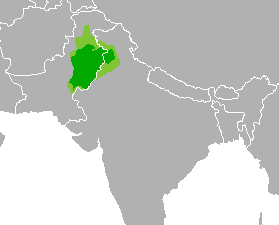Lahnda language
| Lahnda | |
|---|---|
| Western Punjabi | |
| Region | Pakistan |
| Ethnicity | Punjabis |
Native speakers | ca. 25 million (1993–2013)[1] |
|
Indo-European
| |
Standard forms |
Hindko (emerging)
|
| Language codes | |
| ISO 639-2 |
lah |
| ISO 639-3 |
lah – inclusive codeIndividual codes: jat – Jakati hno – Northern Hindko (Kagani) phr – Pahari-Potwari skr – Seraiki hnd – Southern Hindko (Hindko) xhe – ? Khetrani (Note: What Ethnologue includes as "Western Punjabi" is the Eastern Punjabi of Pakistan) |
| Glottolog |
lahn1241[3] |
 | |
Lahnda /ˈlɑːndə/[4] or Western Punjabi are those Indo-Aryan varieties in parts of Pakistani Punjab that are transitional between Eastern Punjabi and Sindhi. The literary language of Lahnda speakers has traditionally been Standard Punjabi.[5]:2
Name
Lahnda means "western" in Punjabi. It was coined by William St. Clair Tisdall (in the form Lahindā) probably around 1890 and later adopted by a number of linguists—notably George Abraham Grierson—for a dialect group that had no general local name.[6]:883 The southern varieties are locally called Saraiki, and northwestern varieties Hindko.
Classification
Since Sindhi, Punjabi, and Hindustani are spoken in a region that has witnessed significant ethnic and identity conflict, all have been exposed to the dialect-versus-language debate. Recently, Saraiki and Hindko are being cultivated as literary languages.[7] The development of the standard written language began after the founding of Pakistan in 1947, driven by a regionalist political movements.[8]:838[9] The national census of Pakistan has counted Saraiki and Hindko speakers since 1981.[10]:46
Varieties
The varieties of Lahnda are:[11]
- Saraiki
- A problematic group of northern dialects wanting a linguistic survey, including Sawain (Sohain), Hindki of Hazara (Kagani), Tinauli
- Hindko proper
- Mirpur Punjabi?
Khetrani is commonly included, but may be a remnant Dardic language.[11] Some of the northern dialects of what has for geographical reasons been considered Gujarati are actually closer to Lahnda. There is also a Lahnda language in Afghanistan and Ukraine in the form of Jakati.
Lahnda has several traits that distinguish it from Punjabi, such as a future tense in -s-. Like Sindhi, Siraiki retains breathy-voiced consonants, has developed implosives, and lacks tone. Hindko, also called Panjistani or (ambiguously) Pahari, is more like Punjabi in this regard, though the equivalent of the low-rising tone of Punjabi is a high-falling tone in Peshawar Hindko.[7]
Sindhi, Lahnda, Punjabi, and Western Pahari form a dialect continuum with no clear-cut boundaries. Ethnologue classifies the western dialects of Punjabi as Lahnda, so that the Lahnda–Punjabi isogloss approximates the Pakistani–Indian border.[12] However, this does not accord with linguistic description, and is not accepted by specialists.
References
- ↑ Lahnda at Ethnologue (18th ed., 2015)
Jakati at Ethnologue (18th ed., 2015)
Northern Hindko (Kagani) at Ethnologue (18th ed., 2015)
Pahari-Potwari at Ethnologue (18th ed., 2015)
Seraiki at Ethnologue (18th ed., 2015)
Southern Hindko (Hindko) at Ethnologue (18th ed., 2015)
? Khetrani
(Note: What Ethnologue includes as "Western Punjabi" is the Eastern Punjabi of Pakistan) at Ethnologue (18th ed., 2015) - ↑ Ernst Kausen, 2006. Die Klassifikation der indogermanischen Sprachen (Microsoft Word, 133 KB)
- ↑ Nordhoff, Sebastian; Hammarström, Harald; Forkel, Robert; Haspelmath, Martin, eds. (2013). "Lahnda". Glottolog. Leipzig: Max Planck Institute for Evolutionary Anthropology.
- ↑ "Lahnda". Oxford English Dictionary (3rd ed.). Oxford University Press. September 2005.
- ↑ Tolstaya, Natalya I. (1981). The Panjabi Language. Routledge. ISBN 9780710009395.
- ↑ Grierson, George A. (1930). "Lahndā and Lahndī". Bulletin of the School of Oriental and African Studies 5 (4): 883–887. doi:10.1017/S0041977X00090571.
- ↑ 7.0 7.1 Shackle, Christopher (2010). "Lahnda". In Brown, Keith; Ogilvie, Sarah. Concise Encyclopedia of Languages of the World. Oxford: Elsevier. p. 635. ISBN 9780080877754.
- ↑ Rahman, Tariq. 1997. Language and Ethnicity in Pakistan. Asian Survey, 1997 Sep., 37(9):833-839.
- ↑ Shackle, C. 1977. Saraiki: A Language Movement in Pakistan. Modern Asian Studies, 11(3):379-403.
- ↑ Javaid, Umbreen (2004). "Saraiki political movement: its impact in south Punjab" (PDF). Journal of Research (Humanities) (Lahore: Faculty of Arts and Humanities, University of the Punjab) 40 (2): 45–55. (This PDF contains multiple articles from the same issue.)
- ↑ 11.0 11.1 Masica (1991)
- ↑ Lahnda language at Ethnologue (18th ed., 2015)
| Western Punjabi edition of Wikipedia, the free encyclopedia |